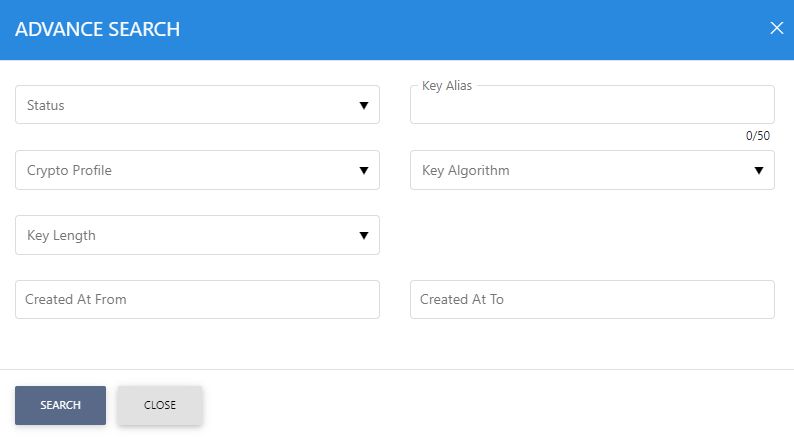User Keys
All the user keys belonging to a registered user can be viewed on the User keys screen as shown below:

Each item in the screenshot is described below:
|
Items |
Description |
||
|
Clear Search |
When a Search is made, this window only displays the filtered records. The Clear Search button is used to view the full set of records. |
||
|
Search |
This opens a new window where search criteria can be entered based on each column of the User Keys grid. |
||
|
|< < > >| |
These buttons are for navigating the different pages of the User Keys.
|
||
|
Key Alias |
Define a name (alias) for the new key. This name has to be unique within the ADSS system.
|
||
|
Key Algorithm/Length |
Shows the Key Algorithm and Length of each register user key. The list includes:
|
||
|
Crypto Profile |
Shows user keys are generate and store whether within the ADSS Server database (software mode) , Azure Key Vault or on a hardware security module (HSM) pre-configured within ADSS Server Key Manager as described in the section Crypto Processor Settings. |
||
|
Security Level |
The Security Level drop-down will be available when ML-DSA is selected in the 'Key Algorithm/Length' field. This drop-down allows the user to choose the security level for the selected key algorithm. The security levels for ML-DSA is defined below:
|
||
|
Created At |
Shows the date and time when the user key was created. |
||
|
Status |
Shows the current status of each registered user key - either Active or Inactive. An inactive key can not be used for signing. |
You can either Activate, Deactivate or Delete a selected User Key. Clicking on the Key Alias will show the user certificate.
Clicking on the Advance Search icon on User Keys page shows the following screen:

This helps to search a particular User Key of a registered user. The User Keys can be searched based on their Status, Key Alias, Algorithm, Key Length, Crypto Profile, Created At From and Created At To. The Security Level search option will be available only when the user selects 'ML-DSA' in the Algorithm field. If a search is based on multiple values, then these will be combined together using the “AND” operand, and thus only records that meet all the criteria will be presented.
See also
User Devices

